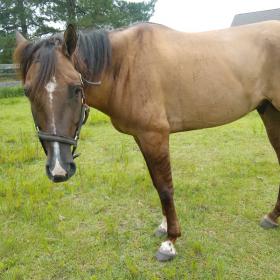I’m unsure if this is the right place for this post, but I’m at a dead end unfortunately. I purchased a gelding at the Carolina Horse Co auction in NC. I had barely seen him, but I paid $700 for him. (I accidentally bid! Haha!) The auctioneer claimed he was a dun 7 year old, used on a ranch and was out of registered QH stock, but they hadn’t received his papers so was being sold as grade. Thats All he said. I couldn’t see him well at all in the dark barn, but when we got him home in the light the next day, I was VERY pleasantly surprised. He is a bay dun, with two white coronets. He has distinct BRINDLE streaks on his left side, a dorsal stripe, very dark leg stripes, lighter stripes on his chest, very dark splotches over his withers and neck, and a very narrow white strip and a lil pink snip. He is the SWEETEST boy, gentle and adores people. I really lucked out. He IS lame in the front left due to a thick collection of scar tissue, but even that looks like its healing and when we ride, he gets bute and hes nearly 100%. (I’m a hobby farm rider, so long as he’s not pained, I don’t mind the lameness.)
But heres why Im here, who has a grade gelding of THIS color?? He does have a brand on his hip, AG. I DID find out who this is, and I will not say his name here for privacy reasons. Lets just call him AG. I did a little facebook stalking (sorry, not sorry.) And found out this man owned my boy in 2015 in PA, and called him both Laid Back Lenny, and Legs. He had photos of him trail riding, roping cattle, and doing quarter races.
I contacted AG, who was ENTIRELY unwilling to help me. He was vague, hostile, and would not answer questions, and eventually told me to stop talking to him because he didn’t care for people who tried to “snoop into a horses past.” So I believe AG sold my boys papers with another horse as he IS a horse dealer. He was selling my boy in 2015 for $7500. All I learned from that talk was that AG bought him in Oklahoma.
So, I instead looked at his coggins. The coggins was paid by Cranbury horse sales in NJ, but was pulled at New Holland. I called Cranbury, and the man on the phone very quickly told me they didnt have any papers and he didnt run through New Holland and hung up with me quickly. Alrighty then. The coggins was pulled 5 days before my boy was at the NC sale, so he had been shipped all over the place before finally selling at NC. he DID have an online bid earlier in the day, for $1800. But that bid was deleted, either by the bidder or seller. He was then run through the auction right near the end and that’s when I got him.
The brindling is a big deal, there are TWO mares that brindling in QHs stems from, but we havent found many babies out of these mares descendents that were born in 2012 with photos on allbreedpedigree. I contacted one of two brindle breeders in the US, and they said he was unfamiliar.
ALL I am looking for is his registered name, I’m just curious! I DID find an allbreedpedigree for a colt named Legs, born in 2012 out of a mare bred in Ontario, and I tried contacting that breeder, but they haven’t emailed back. I’m just kind of at a loss. Today Ill call the NC auction house and see if they can give me any info, but I’m not hopeful.
I’m posting here in the hope that someone may recognize this boy, or any horse he may be out of. Ive named him Salem, and he was claimed to be 15.3 hands, but he is quite a big boy so he is probably taller. He has treated my 26 year old mare like a treasure, grooming her and just being her shadow. I wouldn’t trade him for the world.

